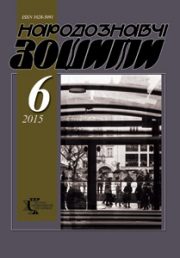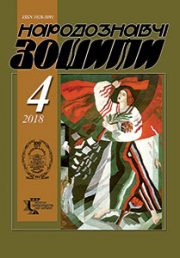The Ethnology Notebooks. 2024. № 1 (175), 159—169
UDK 7.046.3:27-565.7(477)
DOI https://doi.org/10.15407/nz2024.01.159
FEDAK Marta
- ORCID ID: https://orcid.org/0000-0002-8836-8955
- Fellow Researcher of the Ethnology Institute of the National Academy
- of Science of Ukraine,
- National Museum in Lviv named after Andrey Sheptytsky,
- 20, Svobody av., 79008, Lviv, Ukraine,
- Contacts: e-mail: marta_fedak@yahoo.com
Abstract. Introduction. The article considers the creative heritage of the master of the Deesis row painting from Bortne as one of the representatives of the painting center of the second half of the 16th century. The relevance of the topic is stipulated by the need to systematize the monuments of Ukrainian icon-painting by the painting manner of specific masters or art centers.
Problem Statement. In spite of the fact that specific works by the master of the «Deesis» row from Bortne have been subjected to reviews and discussions many times, still the material available remains fully unsystematized and non-attributed. The activity of this anonymous master is often associated with the author of the icon «Transfiguration » from Yabluniv. In spite of different attempts to characterize his painting manner, the works that hypothetically belong to the author of the «Deesis» row from Bortne have not yet been identified.
The Purpose of the article is to systematize the icons in which the manner of the master of the «Deesis» row from Bortne has been traced. The object of the research is iconic works corresponding to the painting manner of the above master. The subejct is their specific artistic and stylistic as well as iconographic features. The core methods in monument processing are stylistic and formal analysis methods. And special features in the interpretation of the plots and schemes have been considered on the basis of iconography and iconology.
Results. While stylistic and painting characteristics of the icon of «Deesis» from Bortne were taken as the basis, other works performed in the related manner have been identified. 12 monuments have thus been identified.
Conclusion. The icons considered, which are referred by us to the creative heritage of the master of «Deesis» from Bortne, are marked with a specific painting manner. All these works were found in the territory of modern Poland and one — in Slovakia. That may well point to the fact that the creativity of this painting center was possibly launched in the Lemko region. According to the artistic and iconographic characteristics of the icons, they are dated the third quarter of the 16th century, probably, the 60ies. Since the icons by the master of «Deesis» from Bortne preceded the creativity of other masters, it is him who should be considered the founder of the new stylistic movement which was further developed and creatively interpreted by the master of icon «Transfiguration » from Yabluniv.
Keywords: icon, iconography, stylistics, painting center, master of the «Deesis» row from Bortne, circle of the master of icon «Transfiguration of the Lord» from Yabluniv.
Received 25.01.2024
REFERENCES
- Fedak, M. (2021). Artistic and iconographic features of the works of the master of the icon «Lord’s Transfiguration» from the church of the Annunciation of the Blessed Virgin Mary in the village of Yabluniv of Turka district. The ethnology notebooks, 3 (159), 675—688 [in Ukrainian].
- Biskupski, R. (1982.). Selected Iconography Workshops of the Halician School in the 15th and 16th centuries. Folia Historie Atrium (Vol. XVIII, pp. 25—42) [in Polish].
- Gronek, A., & Daranowska-Lukaszewska, J. (Eds.). (2019). Works of the circle of «Master Deesis from Bartne». Characteristics of style. Nothing more than the original. A book in memory of Barbara Tondos and Jerzy Tur (Pp. 457—474). Krakow; Rzeszow [in Polish].
- Sventsitska, V., & Sydor, O. (1990). Heritage of the ages. Ukrainian painting of the 14th— 18th centuries in the Lviv museum collections. Lviv [in Ukrainian].
- Helytovych, М., & Skrypnyk, H. (Ed.). (2018). Master of the Icons of the Second Half of the 16th Century from the Church of the Nativity of the Holy Virgin in the village of Liskovate in Western Boyko Region. Art studies: Architecture. Fine Arts, Decorative and Applied Art, 4 (64), 16—27 [in Ukrainian].
- Patriarch Dymytriy, (Yarema). (2017). Western Ukrainian iconpainting of the 16th — first half of the 17th centuries. Lviv [in Ukrainian].
- Winnycka, K. (2013). 16th-century Icons from the Historical Museum in Sanok (Vol. II). Sanok [in Polish].
- Helytovych, М. (2000). The Icons of the Deesis Row in Ukrainian Iconostases of the 15th—16th Centuries. Art Studies of Ukraine. Collection of Scientific Papers (Issue 1, pp. 57—69). Kyiv: Spalakh [in Ukrainian].
- Sventsitskyy-Svyatytskyy, I. (1929). Icons of Halician Ukraine in the 15th—16th centuries. Lviv [in Ukrainian].
- Гелитович, М. (2014). Ukrainian icons of the 13th — beginning of the 16th centuries from the collection of the Andrey Sheptytskyi National Museum in Lviv: catalog album. Lviv: Andrey Sheptytskyi National Museum in Lviv; Kyiv: Master of Books [In Ukrainian].
- Biskupski, R. (1986). Deesis on one canvas in iconpainting of the 15th and the first half of the 16th century. Materials of the Museum of Folk Architecture in Sanok, 29, 106—127 [in Polish].
- Kruk, M. (2000). Western Ukrainian icons of the Virgin and Child from the 15th and 16th centuries. Krakow: Jagiellonian University Publishing House [in Polish].
- Helytovych, M. (2005). Ukrainian Icons «The Christ in Glory». Lviv [in Ukrainian].
- Аleksandrovych, V. (2011). Ukrainian Late Medieval Iconography of Crucifixion: Typology and Functioning. Apologet: Materials of the 4th International Scientific Conference, the city of Lviv, November 24—25 (Pp. 57—70) [in Ukrainian].
- Helytovych, M. (2010). Staryi Sambir Icons of the 14th—16th centuries from the Collection of Andrey Sheptytskyi National Museum in Lviv. Lviv [in Ukrainian].
- Sydor, O., Pavliuk, S.P., & Herus, L.M. (Eds.). (2021). Iconostasis. Church Art of Ukraine: in 3 vol. Decorative Art (Vol. 3, pp. 11—138). National Academy of Sciences of Ukraine; Institute of Ethnic Studies. Kharkiv: Folio [in Ukrainian].
- Giemza, J. (2016). Churches and icons of Lemko area. Ryashin: Libra [in Polish].
- Milyaeva, L., & Helytovych, M. (2007). Ukrainian icon of the 11th—17th centuries. Kyiv: Spiritual Heritage of Ukraine [in Ukrainian].
- Dmytrukh, Sevastiyan (Ed.). (2008). Ukrainian Sacral Art from the Collection «Studion» in the Collection of the Andrey Sheptytskyi National Museum in Lviv (Part ІІ). Lviv: Sribne Slovo [in Ukrainian].
- Helytovych, M. (2008). Saint Nicholas with scenes of his life: Icons of the 15th—18th centuries from the Andrey Sheptytskyi National Museum in Lviv: Art edition. Lviv: Svichado [in Ukrainian].
- Burkovska, L. (2008). The Principles of Constructing Life Cycles of St. Nicholas of Myra in the Ukrainian Icon Painting of the 14th—16th Centuries. Topical Problems of Art Practice and Art Studies (Issue 1, pp. 77—87) [in Ukrainian].







